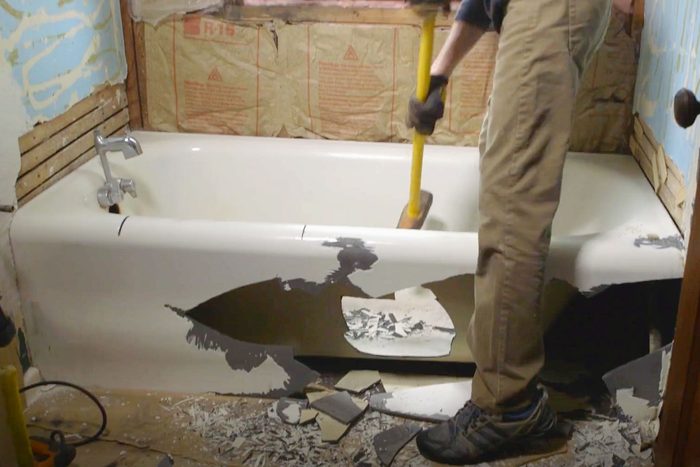Here’s How to Remove a Cast Iron Tub

Removing a cast iron tub is a labor-intensive project, but it can be done by patient DIYers. Here's how.
Cast iron tubs are valued for their strength and water heat retention. But removing them can be an intimidating task. If you want to tackle this chore DIY, you’ll need a good plan, some protective gear and a little determination.
Here’s a rundown of how to remove a cast iron tub, in pieces or intact.
What Is a Cast Iron Tub?
Cast iron tubs consist of a solid iron body with a layer of porcelain enamel around it. They come in drop-in, apron (sometimes called alcove) or freestanding models. In use for centuries, they’re still popular today because they’re hard to damage and retain heat better than acrylic or steel tubs.
How Heavy Is a Cast Iron Tub?
As you might imagine, the more cast iron in a tub, the heavier it is. A freestanding clawfoot tub has more iron than an apron tub, which has more than a drop-in tub.
Looking at modern cast iron tubs, this Kohler drop-in weighs 356 pounds, this Kohler tub with an apron weighs 390 pounds, while this Kingston Brass clawfoot tub weighs 426 pounds.
Older tubs with thicker walls can be even heavier. Expect a vintage clawfoot soaking tub to weigh about 500 pounds. By contrast, even a heavy freestanding acrylic tub weighs 118 pounds.
Ways To Remove a Cast Iron Tub
When former Family Handyman editor-in-chief Gary Wentz examined the most common ways to break up a cast iron tub, he tried four techniques. Check out the video of his experiment, and then we’ll dive into specifics.
Reciprocating saw
Personally, this is my least favorite way to tackle a tub. It’s slow, you’ll tear through blades, and there’s a high chance you’ll nick surrounding materials. This usually isn’t a problem during a complete demo, but if you’re trying to salvage the shower surround or drop-in base, it can be an issue.
Angle grinder
One advantage of an angle grinder: The curved blade can easily navigate the interior curve of the tub. It’s far less likely to damage surrounding materials and doesn’t require much in the way of muscle. However, it’s slow going.
While an angle grinder alone may not be the most effective way to take out a cast iron tub, we’ll see another use for it in the next section.
Demolition hammer
In the video, this is far and away the least effective method. The many rapid strikes lack the single, overwhelming force of a sledgehammer strike.
Sledgehammer
This is the tried and true method for cast iron tub removal, though it takes a fair amount of upper body strength to do it effectively.
How To Remove a Cast Iron Tub with a Sledgehammer
If you want to DIY a tub demo, you’ll need to gather some personal protective equipment (PPE), do a little prep work and then start swinging.
PPE:
- Hearing protection: Tub removal is a loud process taking place in a small room that amplifies sound. Prepare accordingly.
- Eye protection: Shards of cast iron and porcelain enamel will be flying around. That’s an awfully strong reason to put on eye protection.
- Leather gloves: Jagged cast iron is sharp. Wear gloves to avoid a nasty gouge.
- Respirator: This may be optional, depending on the level of airborne debris.
Prep:
- Remove supply lines: The water shutoffs may be close to the tub, but you may need to turn off the supply to the whole house while performing the tear-out.
- Remove waste lines: Begin by removing the overflow and drain assembly. Then remove the waste line. Hopefully you can simply unscrew it. In older tubs, you may need to cut it off.
- Protect any vulnerable surfaces: If you’ve already taken the walls down to the studs, this may simply require covering up a window. If you’re removing a tub from an otherwise untouched bathroom, lay down plywood, moving blankets or other protective material as needed.
Demo:
- Score the surface first (optional): Some pros score the cast iron tub before picking up the sledgehammer. Use an angle grinder with a diamond blade to cut past the enamel and into the cast iron itself. The dual aim: Less sledgehammer force, and more control over where the tub breaks.
- Swing that hammer: With your PPE on and prep work done, start beating on the tub. The underside is reinforced at key points, so if you’re not making much progress, adjust your hammer strikes a few inches in any direction. You can muffle the sound and reduce the chance of flying debris by laying an old towel over the tub surface, although this may dampen or slightly deflect the sledgehammer strikes.
- Removal: Continue until the tub is in small enough pieces to remove by hand.
How To Remove a Cast Iron Tub Intact
You may want to remove your tub intact. Freestanding tubs can be valuable, or you may want to sell or refinish your tub. Drop-in or apron tubs can also be removed intact, although there generally isn’t enough demand for them on the secondary market to make it worthwhile.
Overall, removing a cast iron tub intact isn’t complicated. But it does require forethought and a few helpers. I once worked on a job where a vintage clawfoot soaking tub was taken off-site to be restored and refinished. To pull this off, we used a team of six strong men. (Well, five strong men and me.)
To be clear, the tub didn’t require six people to lift. I doubt we ever had more than four people lifting at once. But navigating anything that large and bulky through a home is tricky. We needed that many hands to move, reposition and hand off the tub through hallways and down a flight of stairs.
Be especially careful on stairways. Letting it slip at that point will be disastrous for anything (or anyone) in its path.


